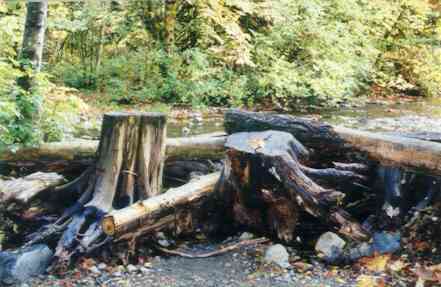Lateral Log-jam Structures (LLJ)
Lateral structure usually fall under one of two designs:
Single-log: a log is placed so that it projects from the bank into the
stream. Attached to a tree or stump on the bank, the log is ballasted with one
or two boulders in the stream channel to prevent movement, especially at high
flows. Also, a group of single logs with rootwads can be complexed.

Traingular: consists of two logs attached separately to trees or stumps
on the bank and both are ballasted by a common anchor or boulder in the stream.
Additional LWD and rootwats can be added once basic structure is complete. Versions
of the triangular complex seem to be more stable than single-log jams and can
also provide more habitat. In construction of these structure one should keep
in mind that;
- larger boulder should be placed at the upstream side of the log
- a fastening and boulder ballast system is required to prevent dislodging
of LWD
- commonly utilized is high strength galvanized cable secured with epoxy resin
- it is helpful to use Design Charts to determine ballast requirements.
Lateral structures:
- consist of logs and rootwads secured to large boulders, aligned or angled
with the stream banks, and attached to tree bases or stumps
- are placed at residual pool sites that had already contained natural LWD
accumulations of a similar nature.
- can serve to armour eroding banks when installed at sharp bends
- are useful in catching debris and organic material
- over time will scour deep pools for habitat and refuge.
- © 2009 Veins of
Life Watershed Society / All Rights Reserved / if you wish to use any info
for commercial or non commercial usage you must obtain permissions from The
Veins of Life Watershed Society

